Abstract
Three typical waste furniture boards, including fiberboard, chipboard, and blockboard, were pretreated with conventional hydrothermal method. The responses of chemical composition, physicochemical morphology, and performances of enzymatic hydrolysis were evaluated. Results indicated the almost complete hemicellulose removal at higher pretreatment temperatures, the enhanced crystallinity index, and disordered morphology of the pretreated substrates indicated that the hydrothermal pretreatment deconstructed these boards well. However, the very low enzymatic hydrolysis (< 8% after 72 h) of the pretreated substrates showed the poor biological conversion. Three hypotheses for the weakened enzymatic hydrolysis were investigated, and results indicated that the residual adhesives and their degraded fractions were mainly responsible for poor hydrolysis. When NaOH post-pretreatment was attempted, cellulose-glucose conversion of the hydrothermally pretreated fiberboard, chipboard and blockboard can be improved to 28.5%, 24.1%, and 37.5%. Herein, the process of NaOH hydrothermal pretreatment was integrated, by which the hydrolysis of pretreated fiberboard, chipboard and blockboard was greatly promoted to 47.1%, 37.3%, and 53.8%, suggesting a possible way to pretreat these unconventional recalcitrant biomasses.





Similar content being viewed by others
References
Diao, G., & Cheng, B. (2013). Analysis on the dynamic relationship between the R&D capacity and trade of China’s furniture industry. International Conference on Management Science and Engineering, 1054–1061.
Xiong, X., Guo, W., Fang, L., Zhang, M., Wu, Z., Lu, R., & Miyakoshi, T. (2017). Current state and development trend of Chinese furniture industry. Journal of Wood Science, 63(5), 433–444.
Nyemba, W. R., Hondo, A., Mbohwa, C., & Madiye, L. (2018). Unlocking economic value and sustainable furniture manufacturing through recycling and reuse of sawdust. Procedia Manufacturing, 21, 510–517.
Abdel-shafy, H. I., & Mansour, M. S. M. (2018). Solid waste issue: Sources, composition, disposal, recycling, and valorization. Egyptian Journal of Petroleum, 27(4), 1275–1290.
Khosravi, S., Khabbaz, F., Nordqvist, P., & Johansson, M. (2014). Wheat-gluten-based adhesives for particle boards: Effect of crosslinking agents. Macromolecular Materials and Engineering, 299(1), 116–124.
Nam, S., Seo, J., Thriveni, T., & Ahn, J. (2012). Accelerated carbonation of municipal solid waste incineration bottom ash for CO2 sequestration. Geosystem Engineering, 15(4), 305–311.
Kim, S., Matsuto, T., & Tanaka, N. (2003). Evaluation of pre-treatment methods for landfill disposal of residues from municipal solid waste incineration. Waste Management & Research, 21(5), 416–423.
Rabl, A., Spadaro, J. V., & Zoughaib, A. (2008). Environmental impacts and costs of solid waste: A comparison of landfill and incineration. Waste Management & Research, 26(2), 147–162.
Halvarsson, S., Edlund, H., & Norgren, M. (2008). Properties of medium-density fibreboard (MDF) based on wheat straw and melamine modified urea formaldehyde (UMF) resin. Industrial Crops and Products, 28(1), 37–46.
Merrild, H., & Christensen, T. H. (2009). Recycling of wood for particle board production: Accounting of greenhouse gases and global warming contributions. Waste Management and Research, 27(8), 781–788.
Raud, M., Tutt, M., Olt, J., & Kikas, T. (2015). Effect of lignin content of lignocellulosic material on hydrolysis efficiency. Agronomy Research, 13(2), 405–412.
Zhang, J., Ma, X., Yu, J., Zhang, X., & Tan, T. (2011). The effects of four different pretreatments on enzymatic hydrolysis of sweet sorghum bagasse. Bioresource Technology, 102(6), 4585–4589.
Cao, W., Sun, C., Liu, R., Yin, R., & Wu, X. (2012). Comparison of the effects of five pretreatment methods on enhancing the enzymatic digestibility and ethanol production from sweet sorghum bagasse. Bioresource Technology, 111, 215–221.
Kelbert, M., Romaní, A., Coelho, E., Pereira, F. B., Teixeira, J. A., & Domingues, L. (2016). Simultaneous saccharification and fermentation of hydrothermal pretreated lignocellulosic biomass: Evaluation of process performance under multiple stress conditions. Bioenergy Research, 9(3), 750–762.
Chen, B., Zhao, B., Li, M., Liu, Q., & Sun, R. (2017). Fractionation of rapeseed straw by hydrothermal/dilute acid pretreatment combined with alkali post-treatment for improving its enzymatic hydrolysis. Bioresource Technology, 225, 127–133.
Menon, V., & Rao, M. (2012). Trends in bioconversion of lignocellulose: Biofuels, platform chemicals & biorefinery concept. Progress in Energy and Combustion Science, 38(4), 522–550.
Ko, J. K., Um, Y., Park, Y.-C., Seo, J.-H., & Kim, K. H. (2015). Compounds inhibiting the bioconversion of hydrothermally pretreated lignocellulose. Applied Microbiology and Biotechnology, 99(10), 4201–4212.
Imman, S., Arnthong, J., Burapatana, V., Champreda, V., & Laosiripojana, N. (2014). Influence of alkaline catalyst addition on compressed liquid hot water pretreatment of rice straw. Chemical Engineering Journal, 278, 85–91.
Imman, S., Laosiripojana, N., & Champreda, V. (2018). Effects of liquid hot water pretreatment on enzymatic hydrolysis and physicochemical changes of corncobs. Applied Biochemistry and Biotechnology, 184(2), 432–443.
Pei, L., Tang, Y., Chen, Y., Guo, C., Zhang, W., & Zhang, Y. (2006). Silicon nanowires grown from silicon monoxide under hydrothermal conditions. Journal of Crystal Growth, 289(2), 423–427.
Zakaria, M. R., Norrrahim, M. N. F., Hirata, S., & Hassan, M. A. (2015). Hydrothermal and wet disk milling pretreatment for high conversion of biosugars from oil palm mesocarp fiber. Bioresource Technology, 181, 263–269.
Grisel, R. J. H., Van Der Waal, J. C., De Jong, E., & Huijgen, W. J. J. (2014). Acid catalysed alcoholysis of wheat straw: Towards second generation furan-derivatives. Catalysis Today, 223, 3–10.
Yoon, S.-Y., Han, S.-H., & Shin, S.-J. (2014). The effect of hemicelluloses and lignin on acid hydrolysis of cellulose. Energy, 77(1), 19–24.
Nitsos, C. K., Choli-Papadopoulou, T., Matis, K. A., & Triantafyllidis, K. S. (2016). Optimization of hydrothermal pretreatment of hardwood and softwood lignocellulosic residues for selective hemicellulose recovery and improved cellulose enzymatic hydrolysis. ACS Sustainable Chemistry and Engineering, 4(9), 4529–4544.
Fernández-Cegrí, V., Ángeles De la Rubia, M., Raposo, F., & Borja, R. (2012). Effect of hydrothermal pretreatment of sunflower oil cake on biomethane potential focusing on fibre composition. Bioresource Technology, 123, 424–429.
Li, M., Chen, C., & Sun, R. (2014). Effect of pretreatment severity on the enzymatic hydrolysis of bamboo in hydrothermal deconstruction. Cellulose, 21(6), 4105–4117.
Ko, J. K., Kim, Y., Ximenes, E., & Ladisch, M. R. (2015). Effect of liquid hot water pretreatment severity on properties of hardwood lignin and enzymatic hydrolysis of cellulose. Biotechnology and Bioengineering, 112(2), 252–262.
Sun, S., Huang, Y., Sun, R., & Tu, M. (2016). Strong association of condensed phenolic moieties in isolated lignins with their inhibition of enzymatic hydrolysis. Green Chemistry, 18(15), 4276–4286.
Yu, Q., Zhuang, X., Yuan, Z., Wang, Q., Qi, W., Wang, W., Zhang, Y., Xu, J., & Xu, H. (2010). Two-step liquid hot water pretreatment of Eucalyptus grandis to enhance sugar recovery and enzymatic digestibility of cellulose. Bioresource Technology, 101(13), 4895–4899.
Zakaria, M. R., Hirata, S., & Hassan, M. A. (2015). Hydrothermal pretreatment enhanced enzymatic hydrolysis and glucose production from oil palm biomass. Bioresource Technology, 176, 142–148.
Boonsombuti, A., Luengnaruemitchai, A., & Wongkasemjit, S. (2013). Enhancement of enzymatic hydrolysis of corncob by microwave-assisted alkali pretreatment and its effect in morphology. Cellulose, 20(4), 1957–1966.
Zhang, H., Xu, S., & Wu, S. (2013). Enhancement of enzymatic saccharification of sugarcane bagasse by liquid hot water pretreatment. Bioresource Technology, 143, 391–396.
Zhao, X., Zhang, L., & Liu, D. (2012). Biomass recalcitrance. Part I: The chemical compositions and physical structures affecting the enzymatic hydrolysis of lignocellulose. Biofuels, Bioproducts and Biorefining, 6(4), 465–482.
Brethauer, S., Studer, M. H., Yang, B., & Wyman, C. E. (2011). The effect of bovine serum albumin on batch and continuous enzymatic cellulose hydrolysis mixed by stirring or shaking. Bioresource Technology, 102(10), 6295–6298.
Hendriks, A. T. W. M., & Zeeman, G. (2009). Pretreatments to enhance the digestibility of lignocellulosic biomass. Bioresource Technology, 100(1), 10–18.
Alriksson, B., Sjöde, A., Nilvebrant, N.-O., & Jönsson, L. J. (2006). Optimal conditions for alkaline detoxification of dilute-acid lignocellulose hydrolysates. Applied Biochemistry and Biotechnology, 129–132(1–3), 599–611.
Subhedar, P. B., & Gogate, P. R. (2014). Alkaline and ultrasound assisted alkaline pretreatment for intensification of delignification process from sustainable raw-material. Ultrasonics Sonochemistry, 21(1), 216–225.
Zheng, Q., Zhou, T., Wang, Y., Cao, X., Wu, S., Zhao, M., Wang, H., Xu, M., Zheng, B., Zheng, J., & Guan, X. (2018). Pretreatment of wheat straw leads to structural changes and improved enzymatic hydrolysis. Scientific Reports, 8(1), 1321.
Yue, Z., Economy, J., & Bordson, G. (2006). Preparation and characterization of NaOH-activated carbons from phenolic resin. Journal of Materials Chemistry, 16(15), 1456–1461.
Castellano, J. M., Gómez, M., Fernández, M., Esteban, L. S., & Carrasco, J. E. (2015). Study on the effects of raw materials composition and pelletization conditions on the quality and properties of pellets obtained from different woody and non woody biomasses. Fuel, 139, 629–636.
Li, Z., Yu, Y., Sun, J., Li, D., Huang, Y., & Feng, Y. (2016). Effect of extractives on digestibility of cellulose in corn Stover with liquid hot water pretreatment. Bioresources, 11(1), 54–70.
Romaní, A., Tomaz, P. D., Garrote, G., Teixeira, J. A., & Domingues, L. (2016). Combined alkali and hydrothermal pretreatments for oat straw valorization within a biorefinery concept. Bioresource Technology, 220, 323–332.
Sun, S., Zhang, L., Liu, F., Fan, X., & Sun, R. (2018). One-step process of hydrothermal and alkaline treatment of wheat straw for improving the enzymatic saccharification. Biotechnology for Biofuels, 11(1), 137.
Wilkinson, S., Smart, K. A., & Cook, D. J. (2014). A comparison of dilute acid- and alkali-catalyzed hydrothermal pretreatments for bioethanol production from Brewers’ spent grains. Journal of the American Society of Brewing Chemists, 72(2), 143–153.
Acknowledgments
Thanks for the Analytical & Testing Center in Sichuan University for the technical supports on SEM and XRD analysis.
Funding
This work was supported by the National Natural Science Foundation of China (grant number 21978183).
Author information
Authors and Affiliations
Contributions
Conceptualization: F.S.; methodology: J.Z. and D.T.; formal analysis and investigation: J.Z.; writing—original draft preparation: J.Z., and D.T.; writing—review and editing: J.H. and F.S.; funding acquisition: F.S.; supervision: F.S; resources, Y.Z., C.H., G.Y., L.L., and S.D.
Corresponding author
Ethics declarations
Conflict of Interest
The authors declare that they have no conflict of interest.
Ethical Approval
This article does not contain any studies with human participants or animals performed by any of the authors.
Additional information
Publisher’s Note
Springer Nature remains neutral with regard to jurisdictional claims in published maps and institutional affiliations.
Electronic supplementary material
ESM 1
(DOCX 888 kb)
Rights and permissions
About this article
Cite this article
Zhao, J., Tian, D., Hu, J. et al. Evaluation of Hydrothermal Pretreatment on Lignocellulose-Based Waste Furniture Boards for Enzymatic Hydrolysis. Appl Biochem Biotechnol 192, 415–431 (2020). https://doi.org/10.1007/s12010-020-03315-9
Received:
Accepted:
Published:
Issue Date:
DOI: https://doi.org/10.1007/s12010-020-03315-9




